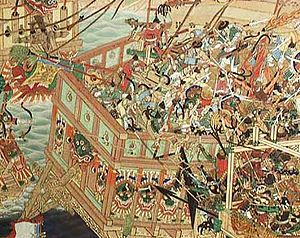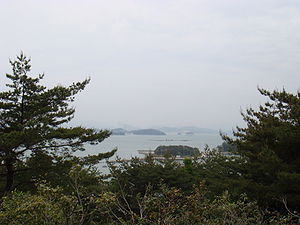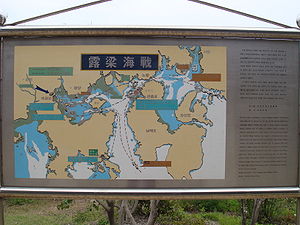- Battle of Noryang
-
Battle of Noryang Part of the Japanese invasions of Korea (1592–1598) 
Part of a Naval Battle Scroll from the Imjin War.Date 16 December 1598 Location Noryang Strait, off the coast of Namhae Island Result Joseon and Ming victory. Belligerents Toyotomi Japan Joseon Dynasty Korea
Ming Dynasty ChinaCommanders and leaders Shimazu Yoshihiro
Tachibana Muneshige[1]
Wakizaka Yasuharu
So YoshitoshiYi Sun-sin †
Chen Lin
Deng Zilong †Strength 500 ships 83 panokseons
63 Ming warships
less than or about 150 total allied ships[2][3]Casualties and losses 200 ships sunk, 100 ships captured.[4] 500 soldiers and sailors.[citation needed] - 1st Busan
- Dadaejin
- Dongnae
- Sangju
- Chungju
- Okpo
- 1st Sacheon
- Imjin River
- Dangpo
- Danghangpo
- Hamgyong
- Yongin
- Hansan Island
- Ichi
- 1st Pyongyang
- 2nd Busan
- Bukgwan
- 1st Jinju
- 2nd Pyongyang
- Byeokjegwan
- Haengju
- 2nd Jinju
- 2nd Danghangpo
- Chilcheollyang
- Namwon
- Myeongnyang
- Jiksan
- 1st Ulsan
- 2nd Sacheon
- 2nd Ulsan
- Suncheon
- Noryang
Battle of Noryang Hangul 노량대첩 Hanja 露梁大捷 Revised Romanization Noryang Daecheop McCune–Reischauer Noryang Taech'ŏp The Battle of Noryang, the last major battle of the Japanese invasions of Korea (1592–1598), was fought between the Japanese navy and the combined fleets of the Joseon and Ming navies. It took place in the early morning of 16 December (19 November in Lunar calendar), 1598 and ended past dawn.
The allied force of about 150 Joseon and Ming Chinese ships, led by Admiral Yi Sun-sin and Chen Lin, attacked and either destroyed or captured more than half of the 500 Japanese ships commanded by Shimazu Yoshihiro, preventing his link-up with Konishi Yukinaga. The battered survivors of Shimazu's fleet limped back to Pusan and a few days later, left for Japan. At the height of the battle, Admiral Yi was shot with a Japanese arquebus, and died shortly after.
Contents
Prelude
Due to a number of setbacks in both land and sea battles, the Japanese armies had been driven back to their network of fortresses, or wajō (和城), on the southeastern Korean coast. However, the wajō could not hold the entire Japanese army so in June 1598, Hideyoshi ordered 70,000 troops of mostly the Japanese Army of the Right to withdraw back to the archipelago.[5] On 18 September 1598, Toyotomi Hideyoshi, the Taikō who instigated the Japanese invasions of Korea (1592–1598), died at Fushimi castle.[6] Hideyoshi's last orders were for the remaining units of the Japanese army, which garrisoned the network of wajō, to begin their withdrawal as well.[7] However, due to the presence of Joseon and Ming ships, the Japanese garrisons in the wajō could not retreat and stayed in the relative safety of their forts.
The Sunch'on wajō was the westernmost Japanese fortress and contained 14,000 troops commanded by Konishi Yukinaga, who was the leader of Japan's vanguard contingent during the first invasion in 1592.[8] Admiral Yi and Chen Lin blocked Konishi from retreat, but Konishi sent many gifts to Chen in an attempt to bribe the Ming commander into lifting the blockade. At first, Chen agreed to withdraw the allied fleet, but Admiral Yi steadfastly refused to comply.[9] Then Chen Lin suggested that the allied fleet attack smaller, more vulnerable wajō, such as the fort at Namhae. Admiral Yi refused that strategy as well. Yi countered that Konishi, who commanded one of the largest wajō, would be allowed to escape if the allies were to leave and fight elsewhere.[10]
On 15 December, about 20,000 Japanese troops from the wajō of Sach'on, Goseong and Namhae boarded 500 ships and began to mass east of the Noryang Strait in an attempt to break the allied blockade of Sunch'on. The overall commander of this relief force was Shimazu Yoshihiro, the leader of the Sach'on wajō.[11]
The objective of the allied fleet was to prevent the link-up of Shimazu's fleet with the fleet of Konishi, then attack and defeat Shimazu's fleet in pitched combat.[12] The objective of Shimazu's fleet was to cross Noryang Strait, link up with Konishi and retreat to Pusan. Shimazu knew that Konishi was making efforts to cause disunity within the allies and hoped that they would be busy elsewhere or still blockading the Sunch'on wajō and thus vulnerable to an attack from their rear.[10]
The battle
On 15 December, a huge Japanese fleet was amassed in Sach'on bay, on the east end of the Noryang Strait. Shimazu was not sure where the allied fleet was. It might have been continuing the blockade of Konishi's wajō, on its way to attack an abandoned wajō further east or blocking their way on the western end of Noryang Strait. Admiral Yi, meanwhile, knew exactly where Shimazu was after receiving reports from scouts and local fisherman.
The Joseon fleet consisted of 82 panokseon multi-decked oared ships.[2] The Ming fleet consisted of six large war junks (true battle vessels most likely used as flagships) that were driven by both oars and sails, 57 lighter war ships driven by oars alone (most likely transports converted for battle use),[3] and two panokseon given to Chen Lin by Admiral Yi. In terms of manpower, the allied fleet had 8,000 sailors and marines under Admiral Yi, 5,000 Ming men of the Guangdong squadron and 2,600 Ming marines who fought aboard Korean ships, a total of almost 16,000 sailors and fighting men.[3][13] The Ming fleet was divided into two squadrons, the larger of which was commanded by Chen Lin and the smaller by Deng Zilong.[3] The allied fleet was well equipped with cannon, mortars, archers and arquebusiers. The Japanese had 500 ships, but a significant part of their fleet consisted of light transports. The Japanese ships were well armed with arquebuses and also had a number of captured Joseon cannons. The allied fleet was outnumbered, but made up for it with ships which, on average, had superior firepower and heavier, more sturdy construction.[3]
The allied fleet waited for Shimazu on the west end of Noryang strait. The battle began at 02:00 on 16 December.[2][11] It was, from the very beginning, a desperate affair with the Japanese determined to fight through the allied fleet and the allies equally determined to keep them from breaking through and advancing.[14]
Like Admiral Yi's previous battles, the Japanese were unable to respond effectively as the Korean and Chinese cannons prevented them from moving.[11] The tightness of the Noryang Strait also prevented any maneuverability.
When the Japanese fleet was significantly damaged, Chen Lin ordered his fleet to engage in melee combat with the Japanese. This, however, allowed the Japanese to use their arquebuses and fight using their traditional fighting style of boarding enemy ships. When Chen Lin's flagship was attacked, Admiral Yi had to order his fleet to engage in hand-to-hand combat as well.
Song Hui-rip, the captain of Admiral Yi's flagship, was struck in the helmet by an arquebus ball and fell unconscious for a time.[15] The vessels got so close that Joseon ships were able to throw burning wood onto the decks of Japanese ships.[15]
Heavy Japanese arquebus fire forced the Chinese sailors to keep their heads low, while the Japanese closed in.[3] Several parties boarded Chen Lin's flagship and in the hand-to-hand fighting that ensued, Chen's own son was injured parrying a sword thrust directed at his father. Seeing Chen's ship in trouble, the Ming left wing commander Deng Zilong and two hundred of his personal guard transferred to a Joseon panokseon (one of two given to the Ming fleet by Admiral Yi) and rowed to his aid.[3] However, several Ming ships, mistaking the panokseon for a Japanese ship, opened fire and disabled it. The stricken panokseon drifted towards the Japanese and they boarded and killed everyone on board, including Deng.[3]
By the middle of the battle, as dawn was about to break, the allied fleet had the upper hand and half of Shimazu's ships were either sunk or captured. It was said that Shimazu Yoshihiro's flagship was sunk and that Shimazu himself was clinging to a piece of wood in the icy water while Chinese grappling hooks were trying to drag him aboard. Japanese ships came to his rescue, pulling him to safety.[15] During the course of the battle, the ships fought from the west end of the strait all the way across to the east end, almost to the open water. The Japanese sustained heavy damage and began to retreat along the south coast of Namhae Island, towards Pusan.[16]
Admiral Yi's death
As the Japanese retreated, Admiral Yi ordered a vigorous pursuit. During this time a stray arquebus bullet from an enemy ship struck Admiral Yi[17] near the armpit, on his left side.[9] Sensing that the wound was fatal, the Admiral uttered, "We are about to win the war -- keep beating the war drums. Do not announce my death."[17] and with these words he died.
Only three people witnessed his death including Yi Hoe, his eldest son, Song Hui-rip, and Yi Wan, his nephew.[17] Admiral Yi's son and nephew struggled to regain their composure and carried the Admiral's body into his cabin before others could notice. For the remainder of the battle, Yi Wan wore his uncle's armor and continued to beat the war drum to let the rest of the fleet know that the Admiral's flagship was still in the fight.[17]
Chen's ship was again in trouble and Yi's flagship rowed to his rescue. Yi's flagship fought off and sunk several Japanese ships and Chen Lin called for Yi to thank him for coming to his aid. However, Chen was met by Yi Wan who announced that his uncle was dead.[18] It is said that Chen himself was so shocked that he fell to the ground three times, beating his chest and crying.[19] News of Admiral Yi's death spread quickly throughout the allied fleet.[18]
Aftermath
Out of 500 Japanese ships under Shimazu's command, an estimated 150 were able to make it back to Pusan Harbor (However, it is said from other Joseon archives and records that Shimazu's remnants were still being fiercely pursued by the Yi Sun-sin's fleet: only 50 ships of Shimazu's Armada ever managed to escape).[20] Konishi Yukinaga left his fortress on December 16 and his men were able to retreat by sailing through the southern end of Namhae Island, bypassing both the Noryang Strait and the battle.[21] Although he knew the battle was raging, he made no effort to help Shimazu. All the Japanese fortresses were now abandoned and Ming and Joseon ground forces moved up to capture them, claim abandoned supplies and round-up stragglers. Konishi, Shimazu, Katō Kiyomasa and other Japanese generals of the Left Army congregated in Pusan and withdrew to Japan on December 21. The last ships sailed to Japan on 24 December,[20] finally bringing an end to seven long years of war.
Admiral Yi Sun-sin's body was brought back to his hometown in Asan to be buried next to his father, Yi Chong (in accordance to Korean tradition). The court gave him the posthumous rank of Minister of the Right. Shrines, both official and unofficial, were constructed in his honor. In 1643, Admiral Yi was given the title of Chungmugong, "Duke/Lord of Loyal Valor".[22]
Chen Lin gave a eulogy while attending Admiral Yi's funeral. He would then return to Ming China to receive the highest military honors to be bestowed on any Ming commander during the war.[22]
See also
References
- ^ War history of Japan: Chousen-eki (1924). Staff headquarters of Imperial Japanese army. ISBN 4-19-890265-8
- ^ a b c Hawley (2005), p. 552
- ^ a b c d e f g h Hawley (2005), p. 553
- ^ 宣祖實錄 宣祖三十一年 十一月二十四日 (The Annals of King Seonjo, November 19, 1598 in Lunar Calendar) "賊船一百隻捕捉, 二百隻燒破, 斬首五百級, 生擒一百八十餘名。 溺死者, 時未浮出, 故不知其數 (Our army captured 100 enemy ships, destroyed 200 ships, beheaded 500 enemy soldiars, and caught 180-plus soldiars alive. The number of drowned enemy soldiars is unknown, because they have still sunk)".
- ^ Turnbull (2002), p. 217
- ^ Turnbull (2002), p. 218
- ^ Hawley (2005), p. 548
- ^ Turnbull (2002), p. 42, 217
- ^ a b Hawley (2005), pp. 549-550
- ^ a b Hawley (2005), pp. 551-552
- ^ a b c Turnbull (2002), p. 226
- ^ Hawley (2005), p. 552, 554
- ^ Choi (2002), p. 213
- ^ Hawley (2005), pp. 553-554
- ^ a b c Hawley (2005), p. 554
- ^ Hawley (2005), pp. 555-556
- ^ a b c d Ha (1979), p. 237
- ^ a b Choi (2002), p. 222
- ^ Hawley (2005), p. 555
- ^ a b Hawley (2005), p. 556.
- ^ Turnbull (2002), p. 227
- ^ a b Hawley (2005), p. 557
Bibliography
- Choi Byung-hyon (translated by) 2002 The Book of Corrections: Reflections on the National Crisis during the Japanese Invasion of Korea, 1592-1598. Institute of East Asian Studies: University of California, Berkeley. ISBN 9781557290762
- Ha, Tae-hung (translated by) 1979 Imjin Changch'o: Admiral Yi Sun-Sin's Memorials to Court. Republic of Korea: Yonsei University Press.[1]
- Hawley, Samuel 2005 The Imjin War: Japan's Sixteenth-Century Invasion of Korea and Attempt to Conquer China. Republic of Korea and U.S.A.: Co-Published by The Royal Asiatic Society and The Institute of East Asian Studies, University of California, Berkeley. ISBN 89-954424-2-5
- Turnbull, Stephen 2002 Samurai Invasion: Japan's Korean War. Great Britain: Cassell & Co. ISBN 9780304359486
Coordinates: 34°56′43″N 127°52′35″E / 34.94528°N 127.87639°E
Categories:- 1598 in Japan
- Naval battles of the Japanese invasions of Korea (1592–1598)
- Naval battles involving China
- 1598 in Korea
- Conflicts in 1598
Wikimedia Foundation. 2010.


